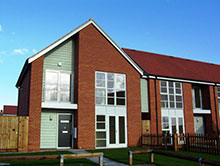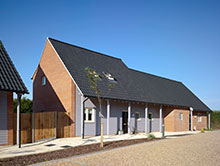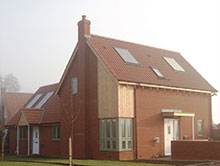Community-led housing
Community-led housing is where local people and communities play a leading role in addressing their own housing needs.
I want to solve my housing needs!
Community-led Housing is a way you can help yourself by getting involved in developing your new home.
As a community, we want to help local people find permanent homes!
As a community member, you can take action by coming together with like-minded people to help develop new homes for your community.
You can make a difference!
Individual people can make a real difference by coming together to take control by building affordable community-led housing.
People involved in community-led housing projects can help decide:
- where the new homes are built
- who will build them and have control of the project
- how many homes
- what they will look like
- who will live in them
Also, the community can have a legal and financial interest in that new housing development.
The following video is courtesy of Community Land Trust Network
North Norfolk District Council could help to support a housing project for you!
Community-Led Housing - What's it all about?
It's about local people
- Playing a leading role in solving housing problems.
- Deciding how the community wants to be involved in bringing new homes and other benefits to their area.
- Creating genuinely affordable homes to meet housing need and help build strong communities.
Community-Led Housing is a way:
- For local communities to provide decent and affordable homes for local people.
- For local people to have the opportunity to have a choice in designing, owning and managing these homes, but taking on the responsibility at a level where they feel comfortable.
- For communities to create income for the use of the community.
Community-Led Housing is a term which is used to describe a range of different ways for communities to address local housing and community needs which can include:
- Working with North Norfolk District Council to build homes on a Housing Exception Sites.
- Community Land Trusts
- Co-operative Housing
- Cohousing
- Self-build and custom build
Examples of communities working together to build new homes across North Norfolk

Swans Close, Langham

Rectory Row, Barney

Bowling Green Lane, Hindringham
North Norfolk District Council works in partnership with Housing Associations to build on Exception Housing Sites, working with Parish Councils and their communities, to build affordable homes for people with a local connection.
Examples of other communities working together in North Norfolk
- Homes for Wells
- Blakeney Neighbourhood Housing Society
- Holt Neighbourhood Housing Society
- Sheringham Stable Door Housing Trust
Community owned assets
Community-Led Housing organisations can own and manage homes and the land they stand on but they can also manage other community assets, such as:
- Open community spaces
- Children’s play areas
- Community halls
- Allotments
- Community shops
- Community pubs
Examples of community owned assets
What's important is that...
- The community is involved throughout the process - what, where and for whom.
- The community will, if they want to, take a role in ownership and/or management of the new homes.
- The community benefits are clearly legally defined and protected for the community now and into the future.
The community benefits of Community-Led Housing can include:
- Keeping families, couples and individuals in the community.
- Giving mutual support, improving a sense of community and connection.
- Giving control over assets and income.
- Providing skills, training and personal development.
- Access to specific funds.
Further information and FAQ's
What is housing need?
Housing need is where a household (individual, couple or family) is unable to afford to rent or buy a home on the open market that meets their needs.
North Norfolk District Council has information about housing need across North Norfolk. We gather this from a list of people who apply to the Council for housing. This lets us identify the number of households who have housing need and a local connection.
What are Affordable Homes?
Affordable housing provides homes for people who cannot afford to rent or buy homes that meet their needs.
Affordable housing means homes let at sub-market rent or housing for sale at sub-market value. For affordable rented homes this means the rent will not be more than 80% of the market rent.
Where can we build?
One of the main ways Community-Led Housing can be built is through using land that would not normally get planning permission for new homes. These are called Exception Sites.
What are Exception Sites?
The Council has specific planning policy which allows the building of housing on Exception Sites. The Council will apply the usual planning policies about the site layout, site access and number of homes; external appearance and landscaping.
Exception Site land is relatively cheap because the land can only be used for affordable housing.
The Council's Exception Housing Scheme policy requires that the
- Housing must meet a proven local housing need.
- The site must adjoin at least ten existing homes in the village.
- Be at an affordable cost for the life of the property.
All will share some common features where:
- The parish/local community is involved.
- There is a landowner willing to sell or donate a site.
- The site is suitable for housing development.
- The development finances work.
How does the community afford to build new homes?
Most Community-Led Housing is financed through a mixture of grants and loans.
- There are grants to help community groups in the early stages.
- There are a number of charitable and ethical lenders.
- These can be combined with funds raised within the community.
- There are also additional loans and grants programmes available.
- On an Exception Housing Site there is another way to fund the building of affordable homes. A small number of market sale homes are permitted but these must only be built to subsidise the cost of affordable homes.
For further information about funding contact a member of the NNDC Community-Led Housing team:
- Anna Clarke, Community Housing Enabler, Anna.Clarke@north-norfolk.gov.uk or call 01263 516428
- Nicky Debbage, Housing Strategy and Delivery Manager, Nicky.Debbage@north-norfolk.gov.uk or call 01263 516027
How do we ensure that local people will live in the new homes?
The Council uses what is called a Local Allocations Agreement to decide who can live in the new homes built on Exception Sites. This agreement makes sure that all affordable homes are prioritised for people who have a local connection.
This agreement gives priority to people with a local connection to the parish where the property is located and the adjoining parishes. This connection will include one or more of the following:
- where you live now
- where you used to live
- where you currently work there
- where you have close family living there
Example of the local connection
Jane Smith who grew up in Trimingham left home to go to college and then moved to Cromer with her boyfriend John. After their marriage and birth of their daughter, Jane and John moved in with Jane's mother. Jane and John couldn't afford a home to rent or buy. This was originally intended as a temporary arrangement but Jane and John have now been living with Jane's mother for four years. Jane's mother has lived in Trimingham for over 20 years.
Jane and John qualify because they have lived in Trimingham for three years and have a family member, Jane's mother, who has lived in Trimingham for over five years.
How do communities decide how to set up their Community-Led Housing Scheme?
There is no set way in which the community must go about setting up and running their project. It's all about what works for local people and the community.
There are a number of models which have been successfully used over a number of years and indeed decades. These offer different benefits to suit each specific community and what they want to achieve.
Each community-led housing scheme will have its own guiding principles. There are some rules and regulations which would also apply.
Contact the Community-Led Housing team to find out more and to find out what advice and information is available
Community Land Trust
This model offers permanent affordability and community control of assets.
- Community Land Trust principals offer a way of providing genuinely affordable housing in perpetuity (forever).
- Assets are held in trust for the benefit of the community and ensure they remain permanently affordable and provide a long-term income.
- Income must be used for the benefit of the community.
- Communities can decide how much ownership and responsibility they want to take on of homes and assets.
- This can also be flexible over a period of time as the community feels comfortable taking more on as skills and experience grow.
- Registered Providers (Housing Associations) are often used to build the new housing and can own and manage the homes, if this works for the community.
Related links
- National Community Land Trust Network - Covers England and Wales offering advice, support and grant funding.
- East Midland Community-Led Housing - Covers Lincolnshire and neighbouring counties working with communities wanting to build community-led housing.
Co-operative
This model offers community accountability and control over housing management.
- Co-operative principals empower residents to democratically control and manage their homes.
- All members need to agree to the terms of the co-operative.
- By running their own homes, many co-operatives improve efficiency and therefore make financial savings.
- Local authorities and Registered Providers (Housing Associations) often come together to support the development of a Co-operative.
Related links
- The Confederation of Co-operative Housing - Are a countrywide organisation that supports co-operative and mutual housing organisations.
- CDS Co-operatives - Are a co-op managing agent who support and promote co-op and community-led housing solutions.
Cohousing
This model helps build stronger neighbourhoods, and offers shared space and mutual support.
- Offers a way for individuals and families to come together to achieve these aims.
- These are intentional communities usually started by a few individuals who attract others to join them to live in a specific lifestyle approach.
- Households have their own homes but residents also have communal facilities which can be used to eat together, grow food and run small community businesses.
- The approach gives full resident control and all need to sign up to a formal legal agreement as to how the community will be run, financed as well as how sharing support, help and chores will operate.
- Registered Providers (Housing Associations) or private developers are employed to develop and build the homes, facilities and communal space.
Related links
- UK Cohousing - Offer further information and a way of making contact with others involved in cohousing projects.
Self-build and custom build
This model offers to help build communities:
- Helps individuals to come together to build their own homes.
- Offers a supported approach for the group through the process.
- The group will learn new skills as well as getting to know neighbours.
- Often built by a developer to custom bespoke/individual design.
- A customer build developer can provide new homes to the group which can range from the provision of a built watertight shell which the owner can then finish to their own specification, through to fully complete bespoke/individual homes.
Related links
How do I get started?
-
Contact the Community-Led Housing team to find out more and to find out what advice and information is available:
- Anna Clarke, Community Housing Enabler, Anna.Clarke@north-norfolk.gov.uk or call 01263 516428
- Nicky Debbage, Housing Strategy and Delivery Manager, Nicky.Debbage@north-norfolk.gov.uk or call 01263 516027
- Locality are the nationwide network supporting community organisations.
- The My Community website support groups and organisations running community-led projects. They have a section about Community-Led Housing with example case studies, a step-by-step guide on how to get a Community-Led housing project up and running and further information about support and grants available.
